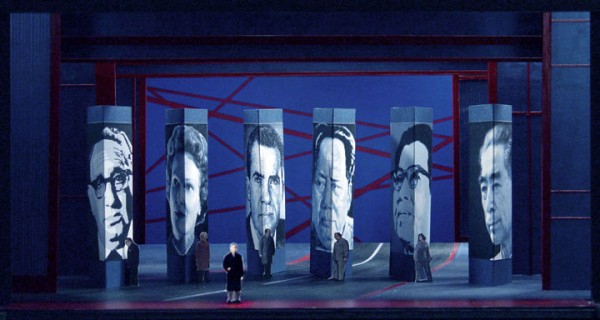Nixon in China: an exercise in rational thought

Kirstie: The easiest way for me to sum up my Nixon in China experience is to say that it felt like an intellectual rather than a dramatic experience. Although the performance was stocked with larger than life characters (Nixon, Mao, Pat Nixon, Mao's wife Jiang Qing, Henry Kissinger, and Mao's premiere Chou En-Lai) their encounter was not framed within a traditional narrative.
There were few points of conflict, and none of the character's personal lives were revealed until the third act. The only real dramatic tension was in the ideological gulf between Mao and Nixon, as it became clear that the Chinese and American visions of “the good life” were radically different and would remain so. Engaging with the opera seemed to mean attending to how philosophical positions were sketched out, rather than being swept up in a grand and heroic tale.
Andrew: I think that’s exactly right. Nixon in China felt like an exercise in rational thought and structure rather than being overly concerned with what the audience experienced as an emotional or even lived experience. Frankly this made the show rather tough going for long stretches, particularly during the first act where one scene, a re-creation of the first private meeting between Mao and Nixon drags on and on. Watching two middle-aged men sit on chairs and sing about the economic impact of trade is not the most gripping experience imaginable.
As you mentioned, there is no exploration of the emotional life of the individuals until the third act, by which point the audience is (or at least I was) beginning to feel deep fatigue. I wonder if the structure was somehow meant to replicate the experience of the participants during that week long visit: from formal meetings and speech giving, through to visits to the countryside and then a sort of dark moment of fear and suspicion (a weird-ass re-creation of a Chinese opera that was put on for the visitors) through to the final monologues that revealed some truths about the participants. But if I remember correctly, these monologues were sung largely as duets that remained firmly within in the existing cultures (ie Pat and Dick singing to one another, Mao and Madam Mao singing to one another) and Chou singing by himself.
Kirstie: I did think that the language of the opera was interesting. The libretto was by Alice Goodman and since it was written in English, we were experiencing its original phrasing and not a translation. The characters' speeches would swing from low to high and back again. I think Mao's first statement upon meeting Nixon (even before he speaks his famous greeting) is something to the effect of "I have a sore throat." Yet in another moment Mao sings of plains full of ripening grain, as numerous as the people of China, and Mrs. Nixon rhapsodizes about a snow halo around the moon. In Act Three, Madam Mao and the Chairman sing a duet about fresh fruit in a garden where they were young lovers together.
There was also an interesting contrast between the language use of the Chinese and the American characters, which I suspect was conscious choice on the part of Goodman. Nixon and Mrs. Nixon's visions of America seemed rather quaint: cold soda and burgers on the grill, safe little bedroom communities where everyone sleeps well at night. Mao and Madam Mao speak in grand terms about burned out huts, blood, starvation, the people overcoming great trials. The contrasting ideologies were depicted not just in what the characters said but in how they said it.
I thought that these contrasts in imagery seemed somehow true to life and to politics. Momentous occasions in world history don't really happen on a transcendental plane. Even powerful people who impose their visions on the world do so amongst all the tedium of daily life. I appreciated that point, although I think it could have been made within the context of a more structured story. I do think the lack of narrative structure raises interesting questions. During the performance, you mentioned that you felt that the music has stood the test of time -- I wonder if maybe the structure of the opera has not? Was it an attempt to have form follow function, a moment of Modernist anti-art that is not as compelling to audiences as it was to artists coming out of the 60s who were bucking existing trends? I feel like I've seen my share of art that makes its point by making audiences uncomfortable, or by evacuating content in favour of form.
The opera reminded me of a piece of Modernist architecture -- austere, monolithic, and comfortless. Something that is remembered for its uniqueness, even if it is not loved for its beauty.
Andrew: Comparing this piece to Modernist architecture is apt. There is none of the vitality or emotional sweep that one associates with opera. It feels like a work that is meant to challenge in the same manner as a math problem might, leaving behind little that was organic and free. Goodman has some amazing turns of phrase and creates some evocative images but her language tends to exist in a poetic space, that is she uses language that is meant to be savoured and thought about, rather than language that exists in the dramatic space of time and action. As a consequence we both spent much of the evening puzzling out particular phrases, rather than simply following the narrative.
This sense of always trying to understand what we were watching meant we were continually pushed outside the frame of the piece and in this manner was extremely post-modern. So, I agree with you the structure/approach felt very much of its time. By the same token, having said all we have about the challenges the work confronts an audience with, I was surprised by the music. It is accessible, often lyrical (to my untrained ear) and has a movie-soundtrack quality. A couple of the refrains still haunt me a couple of days later. It is perhaps surprising at how easy the music is to listen to. This is, in fact, the direct opposite of what I expected going in. Knowing very little about the piece - other than its formidable reputation - I expected to be challenged by the music and not the story.
In terms of the contrasting of the US and China I think you're on the right track but that there were some clever cross-referencing going on as well. For example, the Mao's talk about their experience of the revolution, while Dick Nixon talks about his experience of being in the war. Of course, at one time, the enemy for both the US and China was Japan. Pat Nixon seems somewhat intolerant of her husband's war stories while Madam Mao fully participated, and with relish, in the war her husband waged. This tension between the roles women played in their respective cultures at the time seems to be a core theme of the work.
Kirstie: It's hard for me to see this as a tension -- a contrast yes -- but there was no engagement between characters on these matters, no conversation or conflict. It was interesting that Madam Mao and Pat Nixon had as much or more stage time than their husbands, suggesting that they were being placed in view of the audience for a reason. Yet to me they seemed exceedingly isolated from each other, reiterating the sense that the Americans and Chinese were like ships passing in the night.
In the final scenes, each of the principle characters stands before a huge pillar with his or her face painted onto it. I read this as alluding to the way that the public persona has greater impact than the private figure. Somehow this seemed to be true of the opera itself, that the concept of Mao or Nixon far overshadowed the individual characters as they were written. I really enjoyed the visual impact of this production, and felt that a lot was being said visually that was not being explored by other means. There was a large series of snapshots hanging above the stage in the last act -- Nixon was at one end and Mao at the other. Each picture in between showed one man morphing by degrees into the other. That's a fairly interesting political statement, that Mao and Nixon are two sides of the same coin, perhaps even the same person on some ideological level. Yet nowhere was an idea like that commented on in the opera itself.
Bringing Nixon and Mao into the world of opera gives those who view it and perform it a framework in which to engage with historical material creatively. If art is any kind if mirror of society, then this work is a chance to pause and reflect (as Chou En-Lai does at the end) on the significance of what has passed before us. That said, it seems to me that all we were really given was a framework, with little content -- symbolism without story -- and that very little comment on the past was actually being made.
Andrew: You're right on your last point. The piece is like a great deal of visual art in that it starts and ends with a conceptual framework, the point is the piece itself. In this way, its explorations tend to, for me, to become stilted and arid.
Being writers, we've not surprisingly focused on the narrative and structure of the opera itself rather than the performances. You've mentioned the visual impact of the show, which is quite powerful. There is a stripped down aesthetic at work in Erhard Rom's design, lots of splashes of red, which are complimented by projections designed by Sean Nieuwenhuis which are in themselves subtle. Although I've seen a number of operas over the years, I feel rather ill-equipped to talk technically about the performers. To my dismay, this is the first Vancouver Opera production that I've ever seen and the quality of the performances, under the direction Michael Cavanagh, were generally very high. Robert Orth, as Nixon, and Thomas Hammons as a comic-sidekick Kissinger, were both well cast and I thought that Sally Dibblee provided the right tone of brittle, hair-sprayed devotion. Special mention has to be given to Tracy Dahl who provided a power-house interpretation of Madam Mao, hectoring and frightening in equal measure as she championed the little red book of her distant, philosopher-king husband.



